Steller Sea Lion (Eumetopias jubatus)
Status | Taxonomy | Species Description | Habitat | Distribution |
Population Trends | Threats | Conservation Efforts | Regulatory Overview |
Key Documents | More Info
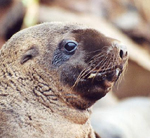 Steller Sea Lion (Eumetopias jubatus) Photo: NOAA's National Marine Mammal Laboratory |
|
Did You Know? · Steller sea lions' impressive low-frequency vocalizations sound more like a "roar" when compared to California sea lions, which sound more like a "bark." |
|
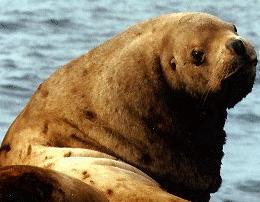 Steller Sea Lion (Eumetopias jubatus) Photo: NOAA's National Marine Mammal Laboratory |
|
Status
ESA Endangered - Western Distinct Population Segment
ESA Threatened - Eastern Distinct Population Segment
MMPA Depleted - throughout its range
Taxonomy
Kingdom: Animalia
Phylum: Chordata
Class: Mammalia
Order: Carnivora
Family: Otariidae
Genus: Eumetopias
Species: jubatus
Species Description
The Steller sea lion, also known as the northern sea lion, is the largest member of the Otariid (eared seal) family. Steller sea lions exhibit sexual dimorphism, in which adult males are noticeably larger than females and further distinguished by a thick mane of coarse hair. Adult males may be up to 10-11 ft (3-3.4 m) in length and can weigh up to 2,500 lbs (1,120 kg). Females are smaller than males, at 7.5-9.5 ft (2.5-3.0 m) in length and weigh up to 770 lbs (350 kg). The coats of adult males and females are light blonde to reddish brown and slightly darker on the chest and abdomen. The light coloration is still visible when the body is wet, which is different from many pinniped species. Like other pinnipeds, their coat of fur "molts" every year. Both sexes also have long whitish whiskers, or vibrissae, on their muzzle. The flippers and other hairless parts of the skin are black. The fore-flippers are broader and longer than the hind-flippers and are the primary means of locomotion in water. On land, sea lions, unlike "true" seals, can turn their hind flippers forward for walking.
Steller sea lions "forage" near shore and pelagic waters. They are capable of traveling long distances in a season and can dive to approximately 1300 ft (400 m) in depth. They also use terrestrial habitat as haul-out sites for periods of rest, molting, and as rookeries for mating and pupping during the breeding season. At sea, they are seen alone or in small groups, but may gather in large "rafts" at the surface near rookeries and haul outs. This species is capable of powerful vocalizations that are accompanied by a vertical head bobbing motion by males. Steller sea lions are opportunistic predators, foraging and feeding primarily at night on a wide variety of fishes (e.g., capelin, cod, herring, mackerel, pollock, rockfish, salmon, sand lance, etc.), bivalves, cephalopods (e.g., squid and octopus) and gastropods. Their diet may vary seasonally depending on the abundance and distribution of prey. They may disperse and range far distances to find prey, but are not known to migrate.
Steller sea lions are colonial breeders. Adult males, also known as bulls, establish and defend territories on rookeries to mate with females. Bulls become sexually mature between 3 and 8 years of age, but typically are not large enough to hold territory successfully until 9 or 10 years old. Mature males may go without eating for 1-2 months while they are aggressively defending their territory. Females typically reproduce for the first time at 4 to 6 years of age, usually giving birth to a single pup each year. At birth, pups are about 3.3 ft (1 m) in length and weigh 35-50 lbs (16-22.5 kg). Adult females, also known as cows, stay with their pups for a few days after birth before beginning a regular routine of alternating foraging trips at sea with nursing their pups on land. Female Steller sea lions use smell and distinct vocalizations to recognize and create strong social bonds with their newborn pups. Pups have a dark brown to black "lanugo" coat until 4 to 6 months old, when they molt to a lighter brown. By the end of their second year, pups are on the same color as adults. Females usually mate again with males within 2 weeks after giving birth. Males can live to be up to 20 years old, while females can live to be 30.
Habitat
Steller sea lions prefer the colder temperate to sub-arctic waters of the North Pacific Ocean. Haul outs and rookeries usually consist of beaches (gravel, rocky or sand), ledges, rocky reefs. In the Bering Sea and Okhotsk Sea, sea lions may also haul out on sea ice, but this is considered atypical behavior.
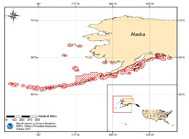 Steller Sea Lion Critical Habitat (AK) (click for larger view PDF) 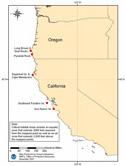 Steller Sea Lion Critical Habitat (CA, OR) (click for larger view PDF) |
Critical habitat has been defined for Steller sea lions as a 20 nautical mile buffer around all major haul-outs and rookeries, as well as associated terrestrial, air and aquatic zones, and three large offshore foraging areas (50 CFR 226.202 on Aug. 27, 1993).
Distribution
Steller sea lions are distributed mainly around the coasts to the outer continental shelf along the North Pacific Ocean rim from northern Hokkaiddo, Japan through the Kuril Islands and Okhotsk Sea, Aleutian Islands and central Bering Sea, southern coast of Alaska and south to California. The population is divided into the Western and the Eastern "distinct population segments" (DPSs) at 144° West longitude (Cape Suckling, Alaska). The Western DPS includes Steller sea lions that reside in the central and western Gulf of Alaska, Aleutian Islands, as well as those that inhabit the coastal waters and breed in Asia (e.g., Japan and Russia). The Eastern DPS includes sea lions living in southeast Alaska, British Columbia, California, and Oregon.
Population Trends
For management purposes, Steller sea lions inhabiting U.S. waters have been divided into two DPSs: the Western U.S. and the Eastern U.S. The differentiation is based primarily on genetic and physical differences, but also on differing population trends in the two regions. There are approximately 39,000-45,000 Steller sea lions in the Western U.S. and 44,500-48,000 in the Eastern U.S.
The Western DPS declined by 75% between 1976 and 1990, and decreased another 40% between 1991 and 2000 (the average annual decline during this period was 5.4%). Since the 1970s, the most significant drop in numbers occurred in the eastern Aleutian Islands and the western Gulf of Alaska. The extent of this decline led NMFS to list the Steller's sea lion as threatened range-wide under the Endangered Species Act (ESA) in April 1990. In the 1990s, the decline continued in the Western portions of the range leading NMFS to divide the species into two distinct population segments (DPS), Western and Eastern, and list the Western DPS as endangered in 1997. Population surveys suggest that the Eastern U.S. DPS is stable or increasing in the northern part of its range (Southeast Alaskan and British Columbia), while the remainder of the Eastern DPS and all the Western DPS is declining.
More information on population trends can be found in NMFS' marine mammal stock assessment reports.
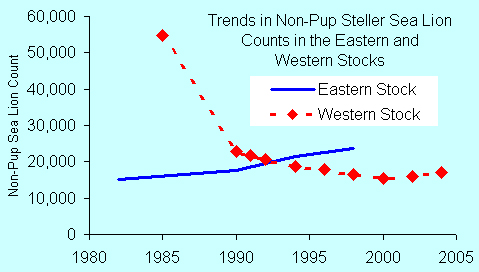
Graph: NOAA's National Marine Mammal Laboratory
Threats
Anthropogenic (or human-induced) threats to Steller sea lions include boat strikes, contaminants/pollutants, habitat degradation, illegal hunting/shooting, offshore oil and gas exploration, direct and indirect interactions with fisheries, and subsistence harvests by natives in Alaska and Canada (150-300 taken a year). In the 1800s, they were targeted by hunters for their meat (food), fur hides (clothing), oil, and various other products. In the early 1900s, fishermen killed and placed bounties on this species, which they blamed for stealing fish from them. Some Steller sea lions were killed to limit their predation on fish in aquaculture facilities (fish farms), but intentional killing of Steller sea lions has not been permitted since they were protected under the Marine Mammal Protection Act (MMPA) and listed under the ESA.
Steller sea lions' direct and indirect interactions with fisheries is currently receiving significant attention and may possibly be an important factor in their decline. Direct fishing impacts are largely due to fishing gear (drift and set gillnets, longlines, trawls, etc.) that has the potential to entangle, hook, injure, or kill sea lions. These pinnipeds have been seen entangled in fishing equipment with what are considered "serious injuries." Steller sea lions are also indirectly threatened by fisheries because they have to compete for food resources and critical habitat may be modified by fishing activities.
Conservation Efforts
Protective zones, catch/harvest limits, various procedures and other measures have been implemented around major haul-outs and rookeries in order to safeguard their critical habitat. The International Union for Conservation of Nature and Natural Resources (IUCN's) Red List of Threatened Species ![]() considers this species to be "Endangered."
considers this species to be "Endangered."
Regulatory Overview
The Steller sea lion was listed under the ESA as threatened throughout its range on December 4, 1990. This listing included animals from Alaska, California, Oregon and Washington in the U.S., as well as Canada, Japan, and Russia.
On June 4, 1997, the population west of 144° W longitude was listed as an endangered DPS (the Western DPS) under the ESA; the population east of 144° W remained listed as threatened as the Eastern DPS.
Under the MMPA, all Steller sea lions are classified as "strategic stocks" and are considered "depleted".
Critical habitat has been designated (50 CFR 226.202 on Aug. 27, 1993) for Steller sea lions as a 20 nautical mile buffer around all major haul-outs and rookeries, as well as associated terrestrial, air, and aquatic zones, and three large offshore foraging areas. NMFS has also designated no-entry zones around rookeries (50 CFR 223.202). NMFS has implemented a complex suite of fishery management measures designed to minimize competition between fishing and the endangered population of Steller sea lions in critical habitat areas.
A recovery plan was developed for Steller sea lions in 1992. A revised recovery plan, which discusses separate recovery actions for the threatened and endangered populations, was issued in 2008.
Key Documents
(All documents are in PDF format.)
| Title | Federal Register | Date |
|---|---|---|
| Recovery Plan (2008) | 73 FR 11872 | 03/05/2008 |
| » 1992 Recovery Plan | n/a | 12/1992 |
| Protection Measures for the Groundfish Fisheries Off Alaska | 68 FR 204 | 01/02/2003 |
| ESA Listing Rule - Endangered Status for Western population | 62 FR 24345 | 05/05/1997 |
| Critical Habitat Designation | 58 FR 45269 | 08/27/1993 |
| ESA Listing Rule - Threatened Status for Eastern and Western populations | 55 FR 49204 | 11/26/1990 |
| Stock Assessment Reports | n/a | various |
- NMFS Alaska Region and Science Center Information on Steller Sea Lions
- NMFS National Marine Mammal Laboratory Steller Sea Lion Information and Research
- NMFS Environmental Impact Statement (EIS) on Steller Sea Lion and Northern Fur Seal Research
- NMFS Southwest Regional Office: CA Pinniped Rookeries & Haul-out Sites
- Marine Mammal Commission Steller Sea Lion Species Information
- U.S. Fish & Wildlife Service Steller Sea Lion Species Profile